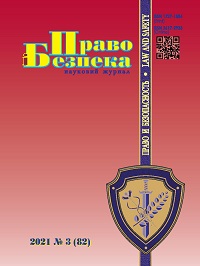Appointment of forensic examinations during the investigation of violence against a law enforcement officer: problems and ways to solve
DOI:
https://doi.org/10.32631/pb.2021.3.11Keywords:
criminal offense, forensic medical examination, law enforcement body, violence, investigative mistakes.Abstract
The aim of the study was to identify common mistakes made by investigators during the appointment of forensic examinations in criminal proceedings initiated in connection with the commission of violence against law enforcement officers, and possible ways to solve them. To achieve this goal, special research methods were used, namely: the method of system analysis, comparative legal method, system and structural and forecasting method, as well as statistical methods, including methods of grouping and analysis of quantitative indicators. It has been established that forensic examinations play an important role in the investigation of violence against law enforcement officers. It is determined that the subject of forensic examination of living persons (establishing the severity of injuries) is to determine a set of issues regarding the type of injuries, their number, nature and location, age and sequence of infliction, determining their severity etc. It is established that on average during the investigation of crimes of this category two examinations are appointed.
On the basis of the performed analysis the possibilities of forensic medical examinations in criminal proceedings of the specified category are defined, and also the typical mistakes which investigators make at their appointment during investigation are identified. The scientific position is substantiated that the typical mistakes are: appointment of several examinations to address the same issues, incorrect definition of the type of examination, failure to provide sufficient medical data needed by the expert to address a number of issues, including criminal proceedings, late appointment of forensic examinations, incorrect posing questions to the expert. Recommendations for preventing certain mistakes are formulated.
It is emphasized that the most effective ways to eliminate the typical mistakes of investigators are to provide systematic training with investigators with the participation of practicing forensic experts. It is proved that the solution of certain problems is possible only by making appropriate changes in the current criminal procedure legislation.
Downloads
References
Guseva, V. O. (2020). Methods of investigating crimes against the authority of public authorities in the field of law enforcement. In the case.
Guseva, V. O. (2021). Theoretical bases of a methods of investigating crimes against authority of public authorities in terms of law enforcement activity [Doctoral dissertation, Kharkiv National University of Internal Affairs].
Ivanov, D. (2021). The importance of a forensic expertise for the establishment and compensation of harm caused by criminal punished actions: Issues of theory and practice. SSRN Electronic Journal. https://doi.org/10.2139/ssrn.3860415.
Krivda, G. F., & Plevinskis, P. V. (2019). On the need to revise and clarify the criteria and terminology used in the rules of forensic medical determination of the severity of physical injuries. Clinical and Experimental Pathology, 18(2), 120–124.
Payne-James, J. J. (2016). Injury, fatal and nonfatal: Injury documentation. Encyclopedia of Forensic and Legal Medicine, 4, 235–241. https://doi.org/10.1016/b978-0-12-800034-2.00218-4.
Pletenetska, A. O., Zarytskyi, H. A., Lehedza, A. V., Polyvianyi, V. M., & Kryzhanovska, V. V. (2021, 26–28 January). Comprehensive forensic assessment of the features of traumatic brain injury with head injury: a case study [Conference presentation abstract]. Second International Scientific and Practical Conference “Scientific community: interdisciplinary research”, Hamburg, Germany.
Schram, B., Orr, R., Hinton, B., Norris, G., & Pope, R. (2020). The effects of body armour on mobility and postural control of police officers. Journal of Bodywork and Movement Therapies, 24(3), 190–194. https://doi.org/10.1016/j.jbmt.2020.03.001.
Senyuta, I., Orlyuk, O., Buletsa, S., & Ivanchulynets, D. (2020). Forensic Medical and Forensic Psychiatric Examination: Some Issues Of Legal Regulation. Georgian medical news, 2(299), 158–163.
Shcherbakovskyi, M. H. (2015). Conducting and using forensic examinations in criminal proceedings. In the case.
Shevchuk, V. (2020, 16–18 July). Problems of formation and improvement of certain criminal methods [Conference presentation abstract]. 5 th International Scientific and Practical Conference “Challenges in Science of Nowadays”, Washington, USA.
Sokol, V. K. (2020). Reasons for not determining the severity of bodily injuries in victims with car injury according to the results of primary forensic medical examinations. Bulletin of Medical and Biological Research, 3(5), 103–107. https://doi.org/10.11603/bmbr.2706-6290.2020.3.11307.
Sokol, V., Olkhovskyi, V., & Kolesnichenko, V. (2020). To the question of establishing the severity of bodily injuries in open fractures of the lower limbs. Actual Problems of Modern Medicine, 6, 41–51. https://doi.org/10.26565/2617-409X-2020-6-06.
Tiesman, H. M., Konda, S., Grieco, J., Gwilliam, M., Rojek, J., & Montgomery, B. (2020). Resistance-related injuries among law enforcement officers: Addressing the empirical gap. American Journal of Preventive Medicine, 59(6), 231–238. https://doi.org/10.1016/j.amepre.2020.05.015.
Zahorodnii, I. V. (2018). Investigation of crimes related to the body harm [Candidate dissertation, National University “Odesa Law Academy”].
Zinenko, Yu. V., & Sergeeva, O. V. (2021). Problems of appointment of forensic medical examinations commission on the facts of inappropriate medical care. Forensics: Yesterday, Today, Tomorrow, 2(18), 38– https://doi.org/10.24412/2587-9820-2021-2-38-46.



